Abstract
Benzene is a clastogenic and carcinogenic agent that induces acute myelogenous leukemia in humans and multiple of tumors in animals. Previous research has indicated that benzene must first be metabolized to one or more bioactive species to exert its myelotoxic and genotoxic effects. To better understand the possible role of individual benzene metabolites in the leukemogenic process, as well as to further investigate inhibition of topoisomerase II by benzene metabolites, a series of known and putative benzene metabolites, phenol, 4,4'-biphenol, 2,2'-biphenol, hydroquinone, catechol, 1,2,4-benzenetriol, 1,4-benzoquinone, and trans-trans-muconaldehyde were tested for inhibitory effects in vitro on the human topoisomerase II enzyme. With minor modifications of the standard assay conditions, 1,4-benzoquinone and trans-trans-muconaldehyde were shown to be directly inhibitory, whereas all of the phenolic metabolites were shown to inhibit enzymatic activity following bioactivation using a peroxidase activation system. The majority of compounds tested inhibited topoisomerase II at concentrations at or below 10 microM. These results confirm and expand upon previous findings from our laboratory and indicate that many of the metabolites of benzene could potentially interfere with topoisomerase II. Since other inhibitors of topoisomerase II have been shown to induce leukemia in humans, inhibition of this enzyme by benzene metabolites may also play a role in the carcinogenic effects of benzene.
Full text
PDF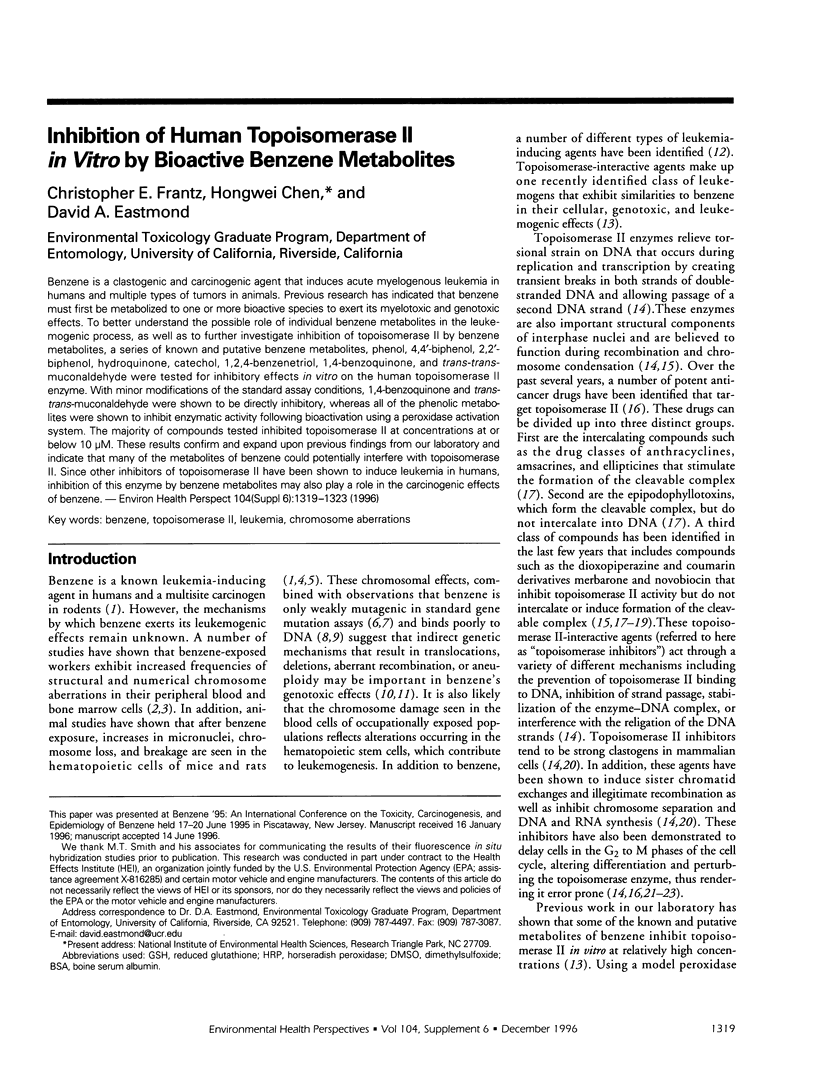
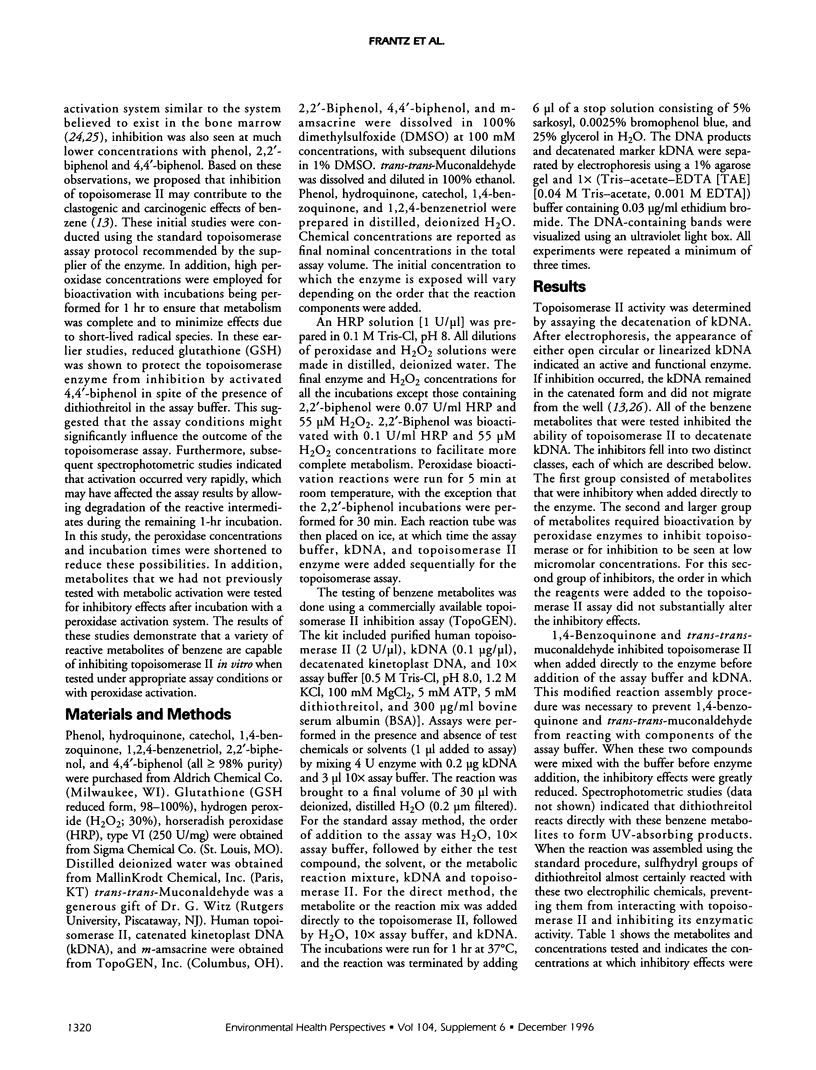
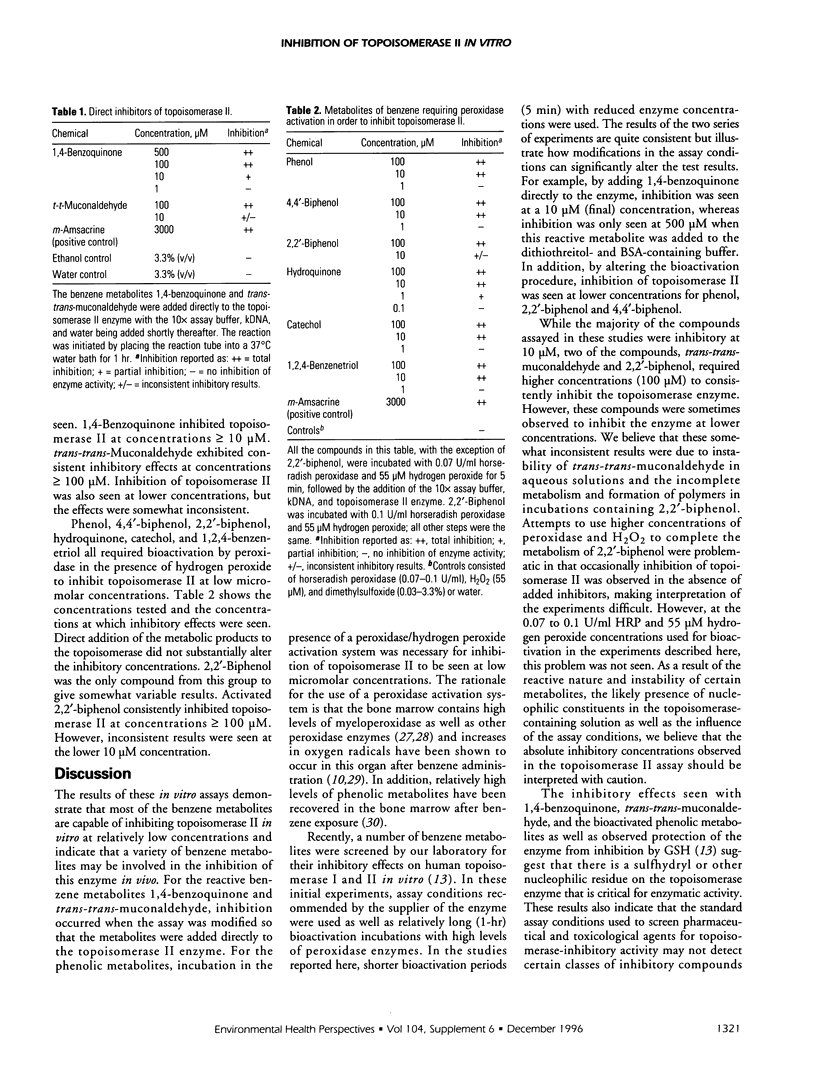
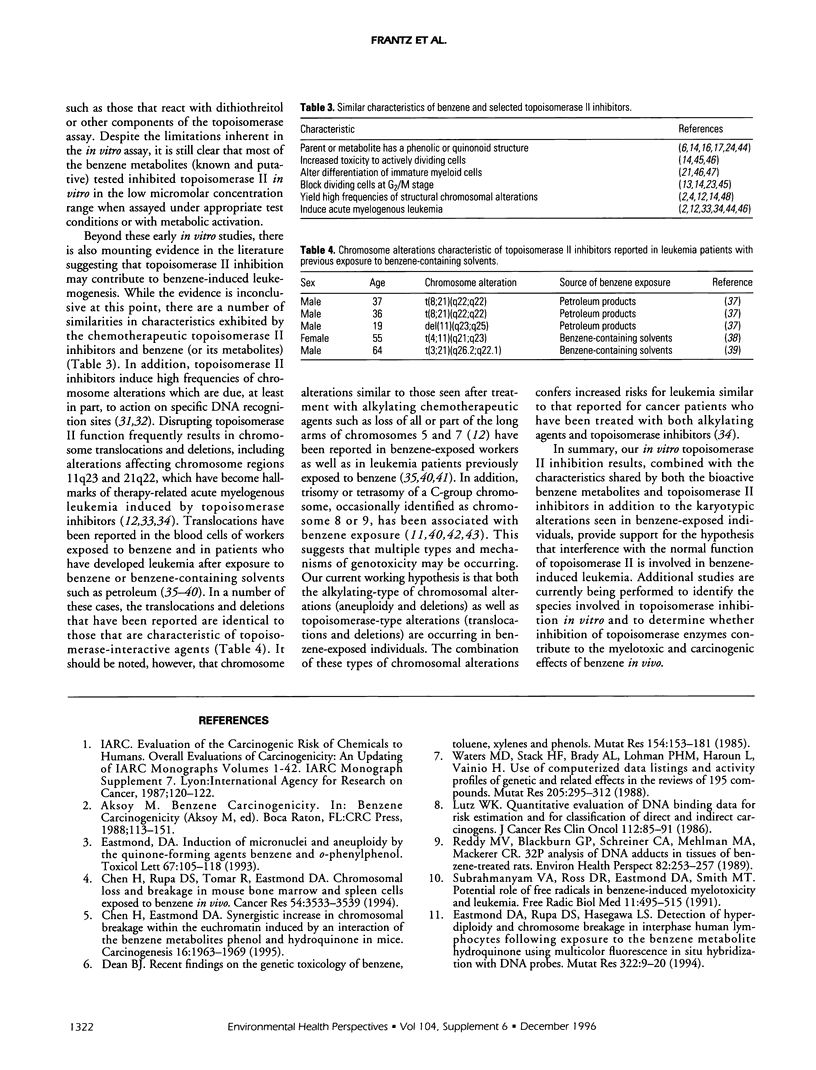
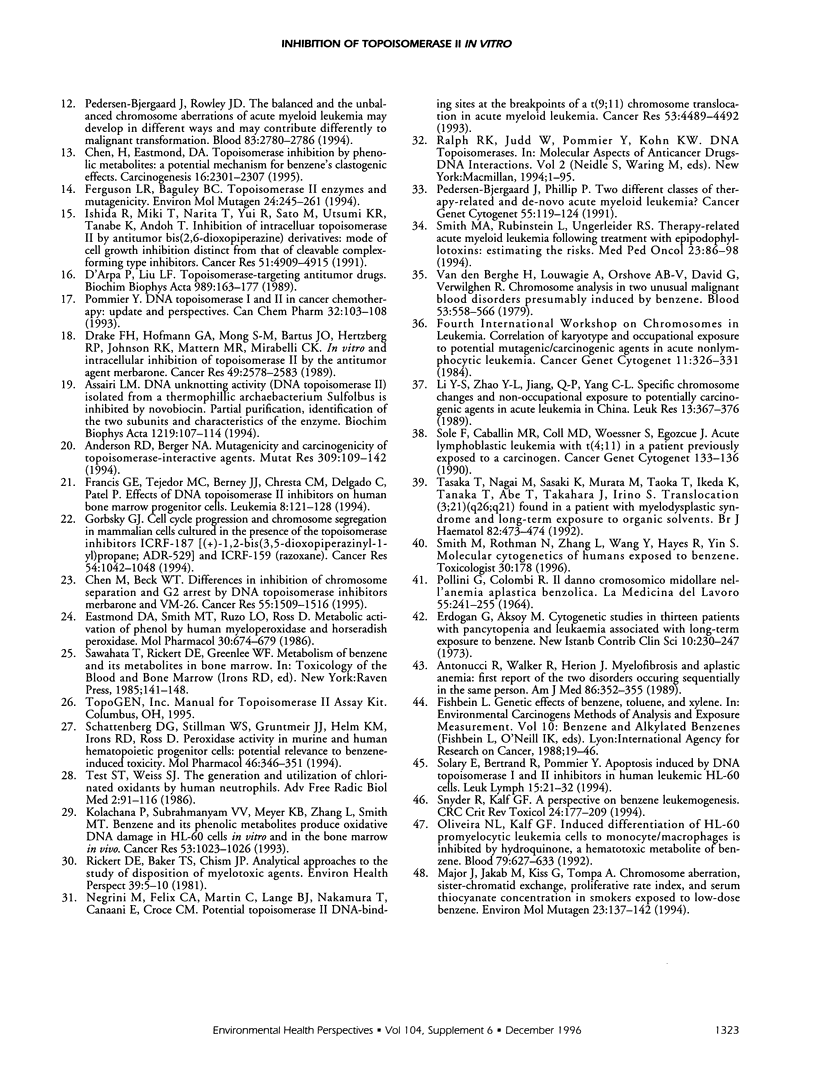
Selected References
These references are in PubMed. This may not be the complete list of references from this article.
- Anderson R. D., Berger N. A. International Commission for Protection Against Environmental Mutagens and Carcinogens. Mutagenicity and carcinogenicity of topoisomerase-interactive agents. Mutat Res. 1994 Aug 1;309(1):109–142. doi: 10.1016/0027-5107(94)90048-5. [DOI] [PubMed] [Google Scholar]
- Antonucci R., Walker R., Herion J. Myelofibrosis and aplastic anemia: first report of the two disorders occurring sequentially in the same person. Am J Med. 1989 Mar;86(3):352–355. doi: 10.1016/0002-9343(89)90314-8. [DOI] [PubMed] [Google Scholar]
- Assairi L. M. DNA unknotting activity (DNA topoisomerase II) isolated from a thermophilic archaebacterium Sulfolobus is inhibited by novobiocin. Partial purification, identification of the two subunits and characteristics of the enzyme. Biochim Biophys Acta. 1994 Sep 13;1219(1):107–114. doi: 10.1016/0167-4781(94)90252-6. [DOI] [PubMed] [Google Scholar]
- Chen H., Eastmond D. A. Synergistic increase in chromosomal breakage within the euchromatin induced by an interaction of the benzene metabolites phenol and hydroquinone in mice. Carcinogenesis. 1995 Aug;16(8):1963–1969. doi: 10.1093/carcin/16.8.1963. [DOI] [PubMed] [Google Scholar]
- Chen H., Eastmond D. A. Topoisomerase inhibition by phenolic metabolites: a potential mechanism for benzene's clastogenic effects. Carcinogenesis. 1995 Oct;16(10):2301–2307. doi: 10.1093/carcin/16.10.2301. [DOI] [PubMed] [Google Scholar]
- Chen H., Rupa D. S., Tomar R., Eastmond D. A. Chromosomal loss and breakage in mouse bone marrow and spleen cells exposed to benzene in vivo. Cancer Res. 1994 Jul 1;54(13):3533–3539. [PubMed] [Google Scholar]
- Chen M., Beck W. T. Differences in inhibition of chromosome separation and G2 arrest by DNA topoisomerase II inhibitors merbarone and VM-26. Cancer Res. 1995 Apr 1;55(7):1509–1516. [PubMed] [Google Scholar]
- D'Arpa P., Liu L. F. Topoisomerase-targeting antitumor drugs. Biochim Biophys Acta. 1989 Dec 17;989(2):163–177. doi: 10.1016/0304-419x(89)90041-3. [DOI] [PubMed] [Google Scholar]
- Dean B. J. Recent findings on the genetic toxicology of benzene, toluene, xylenes and phenols. Mutat Res. 1985 Nov;154(3):153–181. doi: 10.1016/0165-1110(85)90016-8. [DOI] [PubMed] [Google Scholar]
- Drake F. H., Hofmann G. A., Mong S. M., Bartus J. O., Hertzberg R. P., Johnson R. K., Mattern M. R., Mirabelli C. K. In vitro and intracellular inhibition of topoisomerase II by the antitumor agent merbarone. Cancer Res. 1989 May 15;49(10):2578–2583. [PubMed] [Google Scholar]
- Eastmond D. A. Induction of micronuclei and aneuploidy by the quinone-forming agents benzene and o-phenylphenol. Toxicol Lett. 1993 Apr;67(1-3):105–118. doi: 10.1016/0378-4274(93)90049-4. [DOI] [PubMed] [Google Scholar]
- Eastmond D. A., Rupa D. S., Hasegawa L. S. Detection of hyperdiploidy and chromosome breakage in interphase human lymphocytes following exposure to the benzene metabolite hydroquinone using multicolor fluorescence in situ hybridization with DNA probes. Mutat Res. 1994 Jul;322(1):9–20. doi: 10.1016/0165-1218(94)90028-0. [DOI] [PubMed] [Google Scholar]
- Eastmond D. A., Smith M. T., Ruzo L. O., Ross D. Metabolic activation of phenol by human myeloperoxidase and horseradish peroxidase. Mol Pharmacol. 1986 Dec;30(6):674–679. [PubMed] [Google Scholar]
- Erdoğan G., Aksoy M. Cytogenetic studies in thirteen patients with pancytopenia and leukaemia associated with long-term exposure to benzene. New Istanbul Contrib Clin Sci. 1973 Oct;10(4):230–247. [PubMed] [Google Scholar]
- Ferguson L. R., Baguley B. C. Topoisomerase II enzymes and mutagenicity. Environ Mol Mutagen. 1994;24(4):245–261. doi: 10.1002/em.2850240402. [DOI] [PubMed] [Google Scholar]
- Francis G. E., Tejedor M. C., Berney J. J., Chresta C. M., Delgado C., Patel P. Effects of DNA topoisomerase II inhibitors on human bone marrow progenitor cells. Leukemia. 1994 Jan;8(1):121–128. [PubMed] [Google Scholar]
- Gorbsky G. J. Cell cycle progression and chromosome segregation in mammalian cells cultured in the presence of the topoisomerase II inhibitors ICRF-187 [(+)-1,2-bis(3,5-dioxopiperazinyl-1-yl)propane; ADR-529] and ICRF-159 (Razoxane). Cancer Res. 1994 Feb 15;54(4):1042–1048. [PubMed] [Google Scholar]
- Ishida R., Miki T., Narita T., Yui R., Sato M., Utsumi K. R., Tanabe K., Andoh T. Inhibition of intracellular topoisomerase II by antitumor bis(2,6-dioxopiperazine) derivatives: mode of cell growth inhibition distinct from that of cleavable complex-forming type inhibitors. Cancer Res. 1991 Sep 15;51(18):4909–4916. [PubMed] [Google Scholar]
- Kolachana P., Subrahmanyam V. V., Meyer K. B., Zhang L., Smith M. T. Benzene and its phenolic metabolites produce oxidative DNA damage in HL60 cells in vitro and in the bone marrow in vivo. Cancer Res. 1993 Mar 1;53(5):1023–1026. [PubMed] [Google Scholar]
- Li Y. S., Zhao Y. L., Jiang Q. P., Yang C. L. Specific chromosome changes and nonoccupational exposure to potentially carcinogenic agents in acute leukemia in China. Leuk Res. 1989;13(5):367–376. doi: 10.1016/0145-2126(89)90076-3. [DOI] [PubMed] [Google Scholar]
- Lutz W. K. Quantitative evaluation of DNA binding data for risk estimation and for classification of direct and indirect carcinogens. J Cancer Res Clin Oncol. 1986;112(2):85–91. doi: 10.1007/BF00404387. [DOI] [PubMed] [Google Scholar]
- Major J., Jakab M., Kiss G., Tompa A. Chromosome aberration, sister-chromatid exchange, proliferative rate index, and serum thiocyanate concentration in smokers exposed to low-dose benzene. Environ Mol Mutagen. 1994;23(2):137–142. doi: 10.1002/em.2850230211. [DOI] [PubMed] [Google Scholar]
- Negrini M., Felix C. A., Martin C., Lange B. J., Nakamura T., Canaani E., Croce C. M. Potential topoisomerase II DNA-binding sites at the breakpoints of a t(9;11) chromosome translocation in acute myeloid leukemia. Cancer Res. 1993 Oct 1;53(19):4489–4492. [PubMed] [Google Scholar]
- Oliveira N. L., Kalf G. F. Induced differentiation of HL-60 promyelocytic leukemia cells to monocyte/macrophages is inhibited by hydroquinone, a hematotoxic metabolite of benzene. Blood. 1992 Feb 1;79(3):627–633. [PubMed] [Google Scholar]
- Pedersen-Bjergaard J., Philip P. Two different classes of therapy-related and de-novo acute myeloid leukemia? Cancer Genet Cytogenet. 1991 Aug;55(1):119–124. doi: 10.1016/0165-4608(91)90246-q. [DOI] [PubMed] [Google Scholar]
- Pedersen-Bjergaard J., Rowley J. D. The balanced and the unbalanced chromosome aberrations of acute myeloid leukemia may develop in different ways and may contribute differently to malignant transformation. Blood. 1994 May 15;83(10):2780–2786. [PubMed] [Google Scholar]
- Pommier Y. DNA topoisomerase I and II in cancer chemotherapy: update and perspectives. Cancer Chemother Pharmacol. 1993;32(2):103–108. doi: 10.1007/BF00685611. [DOI] [PubMed] [Google Scholar]
- Reddy M. V., Blackburn G. R., Schreiner C. A., Mehlman M. A., Mackerer C. R. 32P analysis of DNA adducts in tissues of benzene-treated rats. Environ Health Perspect. 1989 Jul;82:253–257. doi: 10.1289/ehp.8982253. [DOI] [PMC free article] [PubMed] [Google Scholar]
- Rickert D. E., Baker T. S., Chism J. P. Analytical approaches to the study of the disposition of myelotoxic agents. Environ Health Perspect. 1981 Jun;39:5–10. doi: 10.1289/ehp.81395. [DOI] [PMC free article] [PubMed] [Google Scholar]
- Schattenberg D. G., Stillman W. S., Gruntmeir J. J., Helm K. M., Irons R. D., Ross D. Peroxidase activity in murine and human hematopoietic progenitor cells: potential relevance to benzene-induced toxicity. Mol Pharmacol. 1994 Aug;46(2):346–351. [PubMed] [Google Scholar]
- Smith M. A., Rubinstein L., Ungerleider R. S. Therapy-related acute myeloid leukemia following treatment with epipodophyllotoxins: estimating the risks. Med Pediatr Oncol. 1994;23(2):86–98. doi: 10.1002/mpo.2950230205. [DOI] [PubMed] [Google Scholar]
- Snyder R., Kalf G. F. A perspective on benzene leukemogenesis. Crit Rev Toxicol. 1994;24(3):177–209. doi: 10.3109/10408449409021605. [DOI] [PubMed] [Google Scholar]
- Solary E., Bertrand R., Pommier Y. Apoptosis induced by DNA topoisomerase I and II inhibitors in human leukemic HL-60 cells. Leuk Lymphoma. 1994 Sep;15(1-2):21–32. doi: 10.3109/10428199409051674. [DOI] [PubMed] [Google Scholar]
- Subrahmanyam V. V., Ross D., Eastmond D. A., Smith M. T. Potential role of free radicals in benzene-induced myelotoxicity and leukemia. Free Radic Biol Med. 1991;11(5):495–515. doi: 10.1016/0891-5849(91)90063-9. [DOI] [PubMed] [Google Scholar]
- Tasaka T., Nagai M., Sasaki K., Murata M., Taoka T., Ikeda K., Tanaka T., Abe T., Takahara J., Irino S. Translocation (3;21) (q26.2;q22.1) found in a patient with myelodysplastic syndrome and long-term exposure to organic solvents. Br J Haematol. 1992 Oct;82(2):473–475. doi: 10.1111/j.1365-2141.1992.tb06448.x. [DOI] [PubMed] [Google Scholar]
- Van den Berghe H., Louwagie A., Broeckaert-Van Orshoven A., David G., Verwilghen R. Chromosome analysis in two unusual malignant blood disorders presumably induced by benzene. Blood. 1979 Apr;53(4):558–566. [PubMed] [Google Scholar]
- Waters M. D., Stack H. F., Brady A. L., Lohman P. H., Haroun L., Vainio H. Use of computerized data listings and activity profiles of genetic and related effects in the review of 195 compounds. Mutat Res. 1988 May-Aug;205(1-4):295–312. doi: 10.1016/0165-1218(88)90024-9. [DOI] [PubMed] [Google Scholar]


